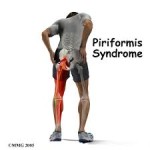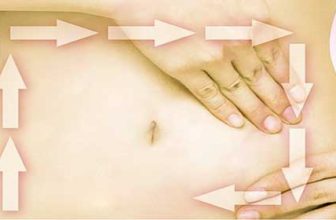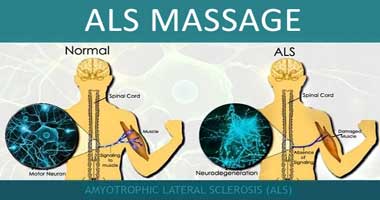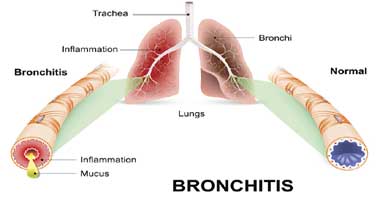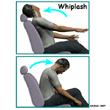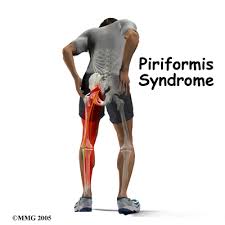
PIRIFORMIS SYNDROME – Compression of the sciatic nerve by the piriformis muscle
Piriformis Syndrome Massage: Functions of the Piriformis:
- The piriformis restrains rapid internal rotation of hip ( occurs with running)
- The piriformis externally rotates femur when hip is neutral or extended
- The piriformis horizontally abducts thigh when hip is flexed to 90 degrees
Piriformis Syndrome Massage: Anatomy – What Happens?
- The sciatic nerve supplies sensory and motor function to skin and muscles of the posterior thigh, leg and foot.
- The Sciatic Nerve is made up of nerve roots L4-S2(S3)- it also contains fibres from both the anterior and posterior divisions of the lumbosacral plexus. The sciatic nerve is comprised of 2 peripheral nerves ( common peroneal and tibial) which travel together until the knee.
- Piriformis muscle inserts on anterior surface of sacrum and medial greater trochanter.
- Sciatic nerve travels under the piriformis and goes distally. In 20% of people, the nerve runs through piriformis
- Increased tension in piriformis can lead to displacement of the sacroiliac (SI) joint ( pulling the SI away towards it <tense piri>) which leads to more trigger points (TP) in piriformis and SI joint dysfunction
- TP in the piriformis are often at lateral border of sacrum and 1/3 of the way medial from greater trochanter. ( closer to GT ) These TP cause the muscle to shorten and become bulkier, compressing the nerve.
CAUSES of Piriformis Syndrome:
- Anomalies in course of nerve ( penetrates piriformis muscle)
- Direct and indirect trauma to piri ( infl, ischemia, spasm, adh, tp–all causing mm to tighten)
- Infammation in the piriformis or adjacent joints ( hip, SI)
- Overuse of the piriformis muscle
- Postural concerns ( flat feet cause internal rotation and adduction of the thighs when walking, piriformis overworks to correct this)
- Trigger points in piriformis ( main thing!)
- Prolonged compression of the nerve may cause sciatic nerve lesion which in turn causes atrophy of the muscles being supplied by the sciatic nerve
SYMPTOMS of Piriformis Syndrome:
- Usually unilateral
- Pain and paresthesia in the posterior thigh, calf, foot. If severe, loss of strength in lower leg, drop foot.
- Pain in the lower back, buttocks, hip and post thigh. Possibly in inguinal area and at greater trochanter due to piriformis trigger points.
- Pain aggravated by: sitting, prolonged hip flexion, adduction and internal rotation, arising from seated position, standing.
- Pain decreased with passive external rotation of hip.. ( active external rotation will hurt —recruitment of the muscles)
- Weakness in abduction, flexion and internal rotation of the affected hip
- SI joint dysfunction due to the shortening and tension in the piriformis
Piriformis Syndrome Massage: OBSERVATION
- Guarding of affected limb
- Ataxic gait due to pain
- Difficulty sitting/standing prolonged due to pain
- Torsion of hips ( because of SI joint dysfunction ) ( kind of rotated)
- When Supine, external rotation of the affected leg
- May be swelling in lower limb with extreme long-term nerve compression
Piriformis Syndrome Massage: PALPATION
- Trigger Points and Hypertonicity in the piriformis, also in gluteals, quads, psoas, quadratus lumborum
- Tenderness over the piriformis
- Swelling at piriformis or lower limb ( edema- lack muscular pump)
Piriformis Syndrome Massage: ORTHOPEDIC TESTING
- AF and PR ROM decreased in internal rotation of the affected hip
- AR testing of affected hip weak and painful
SPECIAL TESTS:
- Pace abduction test
- Piriformis length test
- Freiburg’s Variation of SLR
- Gaenslen’s Piriformis Massage Therapy Treatment
Differentiating Radiating Pain:
 Compression of nerve from herniated disc- similar symptoms. Valsalva’s, Kemp’s, Kernig’s, Slump, SLR (+), no tenderness on the piriformis area, pain in lower back area
 Facet Jt. Irritation — Kemp’s/ Quadrants (+), no tenderness at the piriformis area.
Piriformis Massage Therapy Treatment:
- Treat around the Greater trochanter–lots of muscle attachments
- Ligaments- sacrotuberous ( ischial tuberosity to the sacrum) to release sacrum..
- Fascial work over buttocks ( fascial spreading)
- Entire gluteal area treated using petrissage
- Treat glute max thoroughly so piriformis can be reached. Treat glue medius and minimus.
- General Massage Treatment – Along iliac crest, Around sacrum, Around gr. Trochanter
- Landmark piriformis, ask patient to externally rotate hip so that the piriformis muscle contracts.
- Treat piriformis using origin and insertion, finger kneading, muscle stripping, ischemic compressions to piriformis trigger points – follow up with piriformis stretch
- Passively rotate patient’s hip internally and externally while applying pressure to piriformis ( with fist works well)
- To Stretch piriformis – ( move hip into internal rotation)
Piriformis Syndrome Massage: SELF CARE
- Self stretch to the piriformis
- Tennis ball to glutes and piriformis
- Avoid sitting with knees rolling out to the side
- Sleep with pillow between knees to avoid internal rotation of the hip ( stretching the piriformis for too long will irritate it, better to be in neutral)
- Take breaks from aggressive activities/ running to stretch
- Chiro adjustment for SI joint displacement
